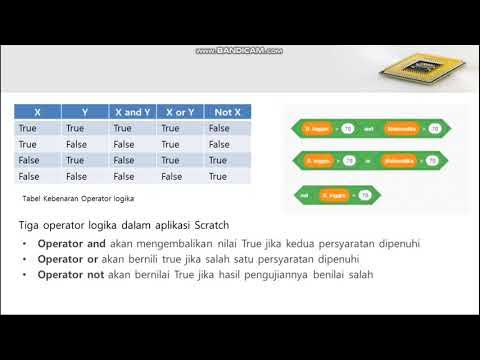Operator Perbandingan dan Logika
Summary
TLDRThis educational video focuses on using conditional branching in programming, specifically through comparison and logical operators. It explains how boolean data types (true/false) work with operators like greater than, less than, and equal to for comparisons. The video also covers logical operators such as AND, OR, and NOT, demonstrating their usage with practical examples, including grade assignments based on numeric ranges and fruit orders. The instructor provides clear examples of how these operators function, with emphasis on understanding their practical applications in programming and logical reasoning.
Takeaways
- 😀 The topic is about using conditional branching with comparison and logical operators in programming.
- 😀 The application discussed is Scratch, which was used in grade 7 to create games and animations.
- 😀 Comparison operators used in Scratch include 'greater than', 'less than', and 'equal to'.
- 😀 Logical operators in Scratch include 'AND', 'OR', and 'NOT'. These help control the flow of conditions.
- 😀 Boolean data types are used for conditions, with two possible values: 'true' (correct) and 'false' (incorrect).
- 😀 The script provides examples of using comparison operators with values to produce true or false results based on comparisons.
- 😀 For example, if the value is 80 and the condition is 'greater than 50', the result is true, while 40 would return false.
- 😀 The script also explains how grading systems use these comparison operators to assign grades based on score ranges (A, B, C).
- 😀 Logical operations like 'AND' (true when both conditions are true) and 'OR' (true when at least one condition is true) are explained with examples.
- 😀 The 'NOT' logical operator is explained as flipping the value of a condition; if a condition is true, 'NOT' will make it false, and vice versa.
- 😀 Examples are provided to demonstrate how 'AND', 'OR', and 'NOT' work in practical scenarios like ordering fruits or checking conditions.
Q & A
What are the two types of operators discussed in the script?
-The two types of operators discussed are comparison operators and logical operators.
How many comparison operators are used in the application mentioned?
-The application uses three comparison operators: greater than, less than, and equal to.
What type of data is used for the conditions in the application?
-The data type used for conditions is boolean, where the values are either true or false.
What happens when a value of 80 is compared to 50 using the 'greater than' comparison operator?
-The result will be true because 80 is greater than 50.
What is the outcome when comparing 40 to 50 using the 'greater than' operator?
-The result will be false because 40 is not greater than 50.
What does the logical operator 'AND' (n) do in the example with 'banana' and 'pineapple'?
-The 'AND' operator checks if both conditions are true. For example, if both 'banana' and 'pineapple' are ordered, the result is true. If one of them is missing, the result is false.
How does the 'OR' logical operator work in the context of ordering fruits?
-The 'OR' operator checks if at least one of the conditions is true. For example, if either 'banana' or 'pineapple' is ordered, the result will be true.
How is the 'NOT' operator explained in the script?
-The 'NOT' operator inverts the condition. If the condition is true, the result becomes false, and if the condition is false, the result becomes true.
What happens when a false value is passed through the 'NOT' operator?
-When a false value is passed through the 'NOT' operator, the result is true because 'NOT' inverts the value.
What is the difference between using 'AND' and 'OR' in logical operations?
-In 'AND', all conditions must be true for the result to be true, while in 'OR', only one condition needs to be true for the result to be true.
Outlines

This section is available to paid users only. Please upgrade to access this part.
Upgrade NowMindmap

This section is available to paid users only. Please upgrade to access this part.
Upgrade NowKeywords

This section is available to paid users only. Please upgrade to access this part.
Upgrade NowHighlights

This section is available to paid users only. Please upgrade to access this part.
Upgrade NowTranscripts

This section is available to paid users only. Please upgrade to access this part.
Upgrade NowBrowse More Related Video

Informatika Kelas 8 Menggunakan Kondisi Percabangan Hal. 93-100

Belajar Python [Dasar] - 12 - Latihan Komparasi dan Logika

Introduction to Operators in C

If Else Statements in Python | Python for Beginners

Minggu 3 - Eksekusi Kondisional

IGCSE Computer Science 2023-25 - Topic 7: Video 2b - PSEUDOCODE Part 1
5.0 / 5 (0 votes)